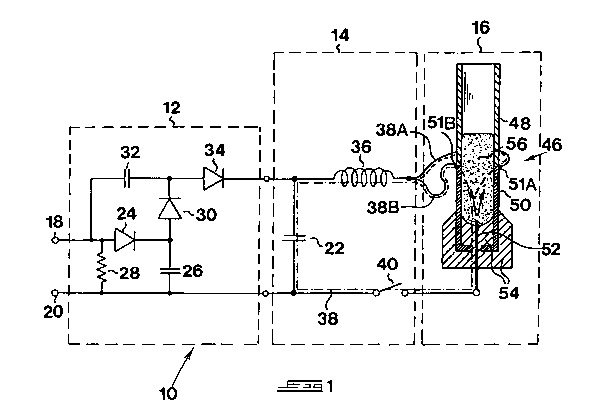Water Gun Theory
I recently read an interesting patent which describes
a capacitor driven water droplet launcher. U.S.
Patent 6,220,141 "Liquid Projectile Launcher" claims that this device
can deliver a water droplet at high speed (1000 m/s, ~Mach 3) at "short
to medium range". The authors also suggest various additives to the
water to produce desired effects on the target. These include humanitarian
substances, such as vaccines or antibiotics, as well as more nefarious
materials such as acids, bases or solvents to generate a pain response
(having at one time or another spilled all of these things into open cuts,
I can testify that they do indeed sting), capsaicin (hot pepper oil) for
more serious pain, or histamine (do not pass go, do not collect $200, go
directly to anaphylactic shock). For more ideas along these lines,
see my chemophobia page.
The principle claim of this patent is that the
use of multiple conductors (or better, a coaxial arrangement) to feed power
to the drive portion of the barrel results in a more spatially coherent
liquid projectile with a longer effective range. I have a couple
of problems with this patent. First, the range specification was
very unclear. It seems unlikely to me that a water droplet would
be aerodynamic enough to maintain coherence over a distance of more than
an inch or two. I wanted to test this. Second, the design presented
in the patent is clearly a single shot device. The capacitor is charged
from a built in voltage multiplier powered by mains supply. The described
trigger is a simple switch with two metal strips which are designed to
fuse together on operation. Although the patent calls for the inclusion
of a sliding device to pry apart the contacts after use, a second shot
would require plugging it in to recharge the capacitor and refilling the
breech with liquid using a syringe type dispenser.

This is the schematic of the water gun, taken
directly from the patent. The section within the dashed box twelve
is a voltage multiplier for charging the main capacitor, 22, from 220 VAC
mains (the patent is assigned to a British company, Injectiles Ltd.).
The gun itself is depicted within the dashed box 16, with the muzzle pointed
up. The patent claims that the liquid projectile, 56, preferably
has a maximum mass of 0.1 grams. The barrel consists of a muzzle
end, 48, which should be non-conductive, between 2 and 3.5 mm in internal
diameter and 20 to 50 mm in length and a breech end, 50, which should be
conductive and the same diameter as the muzzle end. An electrically
conductive pin, 52, serves as the second electrode in contact with the
projectile. The patent suggests that capacitor 22 has a value of
150 mF and is charged to 1000 volts, giving
a stored energy of 75 joules. The inductance, 36, totals ~0.5mH,
giving a discharge frequency of 18 KHz.
Upon closure of switch 40, the patent claims that
a portion of the projectile is converted into a 3000-6000 ºC plasma
which is accelerated down the conductive portion of the barrel, like the
plasma armature of a rail gun, pushing the remaining
portion of the liquid projectile in front of it.

